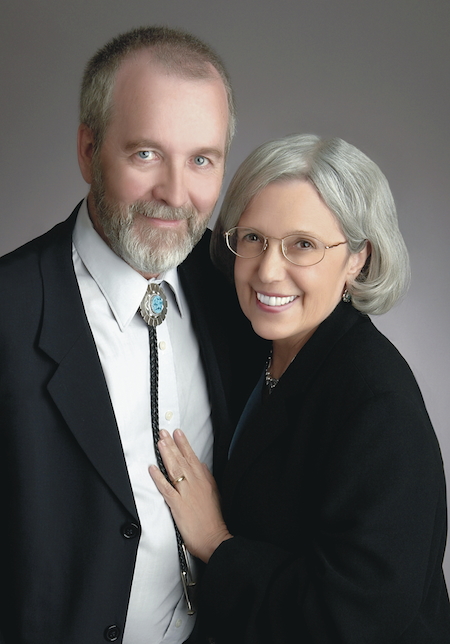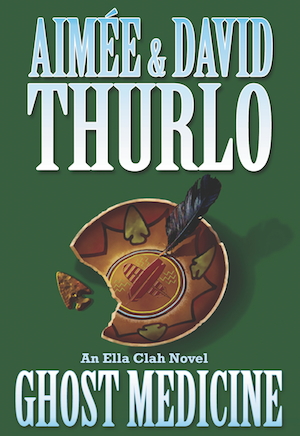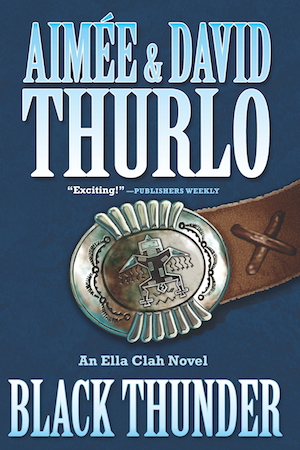 Partners in work and life, this writing duo has an abiding love for America’s West.
Partners in work and life, this writing duo has an abiding love for America’s West.
Aimée and David Thurlo are a dynamo team—43 years together as a couple and 84 books published with more waiting in the wings. In addition to many romantic suspense novels, the Thurlos have written three different mystery series, each featuring a very different primary investigator. In the Sister Agatha series, mysteries are solved by a nun; the Lee Nez series features a partnership between a Navajo vampire and an FBI agent.
Their flagship series of Ella Clah police procedurals is set on the Navajo Reservation near Shiprock, New Mexico, where David grew up. Ella Clah is a Special Investigator for the Navajo Police Department and her 17th case, Ghost Medicine, was published in November.
Since 1995 the two of you have written 29 mysteries, if my count is correct, as well as a number of romances. What made you decide to write together?
Aimée: David and I have been married 43 years, so doing stuff together comes more naturally to us than going solo. It’s more fun, too. When something terrific happens, it’s great to have a partner to share it with. I think it was Oprah who said that one of the hardest things in life is finding another person to be truly happy for you. Only a partner can know how difficult it was to give up a perfect day to stay indoors and write, and how many times a scene had to be rewritten before you could move on.
I read somewhere that you were married three weeks after meeting...true? If so, tell me about that!
Aimée: I moved in to the apartment next door to David’s right after the Fourth of July. We met shortly after that and fell head over heels in love. I knew he was The Guy for me. He felt the same way about me, so July 31st, we got married. Neither of us ever doubted for a moment that it was the right decision. Forty-three years later, we still say it was the best thing we ever did. We’re best friends who live and work together. It really doesn’t get better than that.
You are best known for the Ella Clah series and you’ve written a number of books featuring her (and one featuring her mother...). I’m also assuming that you’re pretty tied into the Navajo community. What are their thoughts about the books?
 David: I grew up in Shiprock, on the Navajo Nation. As a member of a minority living among the tribe, I gained respect for the Navajos, and, at the same time, developed friendships that have lasted to this day. During our last visit to the Navajo Nation, we were invited to speak at The Phil—the community theater and cultural center in Shiprock. Our audience was packed with Navajo readers, and everyone was pleased with our stories, our ability to convey the cultural bridge between modernists and traditionalists—and at the same time giving them a great mystery.
David: I grew up in Shiprock, on the Navajo Nation. As a member of a minority living among the tribe, I gained respect for the Navajos, and, at the same time, developed friendships that have lasted to this day. During our last visit to the Navajo Nation, we were invited to speak at The Phil—the community theater and cultural center in Shiprock. Our audience was packed with Navajo readers, and everyone was pleased with our stories, our ability to convey the cultural bridge between modernists and traditionalists—and at the same time giving them a great mystery.
You have highlighted a number of issues facing Native American communities. What do you think are some of the biggest challenges today?
David: Native Americans face the same problems as the rest of the country: access to health care, getting a good education, and dealing with poverty. There is also the added problem of jobs and underemployment. Unfortunately, many Navajos who get a good education are forced to leave the rez in order to apply those skills. The Navajo Nation still has problems with access to good housing, water for household use and irrigation, and a reliable road network.
I am curious about your inspiration for each story. Is it character, plot, setting?
David: Ella Clah came about on our way back from the Navajo Nation after attending my high school reunion. We wanted a female character who was a strong leader and had investigative skills. What we were determined to avoid was a female cop who was constantly in danger because she made dumb mistakes, or one who continually needed to be rescued by a male officer. So, Ella became an FBI agent who took leave to come home and look into her father’s murder—unofficially. After the case was closed, she remained on the rez as a member of the tribal police.
You must do a significant amount of research in order to fold in Native American history and tradition as you do and yet don’t make the books sound like an anthropology lesson. Do you enjoy the research?
David: So much of our research involves working with our sources—former classmates of mine, law enforcement officers, government agents, local experts, and Navajo language instructors. We also draw from my many years on the Navajo Nation and my experiences there. We go back to my hometown, Shiprock, as often as we can, too. It helps us enrich the stories with small details that make the setting come alive.
In your new book, Ghost Medicine, Ella Clah seems to be at a turning point in her life—what is next for her and you?
 Aimée: The Ella Clah series will go on hiatus for a while. Right now we need to concentrate on our new Trading Post series. Each of these romantic suspense books will focus on one of the people who work at The Outpost, a trading post just outside the Navajo Nation. The owner, Jo Buck, is a Navajo medicine woman in training. The first book, A Time for a Change (Forge, 2013) featured Jo. The second book, Looking Through the Darkness, will be out next April.
Aimée: The Ella Clah series will go on hiatus for a while. Right now we need to concentrate on our new Trading Post series. Each of these romantic suspense books will focus on one of the people who work at The Outpost, a trading post just outside the Navajo Nation. The owner, Jo Buck, is a Navajo medicine woman in training. The first book, A Time for a Change (Forge, 2013) featured Jo. The second book, Looking Through the Darkness, will be out next April.
David: The first book in our new mystery series for Minotaur, The Pawnbroker, will be published in January 2014. This story features Charlie Henry, the proud new co-owner of a pawnshop. Charlie and his best friend and business partner, Gordon, have recently returned Stateside from special-ops work in Iraq.
I understand that CBS had talked about an Ella Clah TV series. Tell me about that.
Aimée: Lee Goldberg and Bill Rabkin wrote a wonderful screenplay based on our Ella Clah books. CBS optioned it, but it never made it into production. Lee and Bill have now published that script in book form, Aimée and David Thurlo’s Ella Clah—The Pilot Script (CreateSpace, 2013). It’s a must for anyone who wants to know how to translate books into screenplays. They took our character, and without changing the essence of her, created a strong TV heroine.
And then there’s Lee Nez, the vampire police officer. How does one blend Navajos and vampires?
David: I grew up hearing stories of skinwalkers, Navajo witches who wore wolf or coyote skins and preyed upon the people. They were also believed to be capable of transforming from human to animal form and vice-versa. This concept fit well with the stories of werewolves, and when these creatures are around, you usually find vampires as well. So, I came up with the idea of Nightwalkers—the Navajo equivalent of vampires, except that with my biology background (I taught science for 25 years), I decided my vampires wouldn’t be the undead. They’d be a very small number of humans carrying a subvirus that made them vampire-like.
What are you working on now?
Aimée: Our Copper Canyon series for Harlequin Intrigue is going strong. Each book focuses on one of six foster brothers raised by a Navajo medicine man. Our work in progress, Undercover Warrior, features an NCIS agent who comes home to solve a case involving specialized explosive devices stolen from a naval base abroad. Throughout the story, the hero will have to come to terms with things he never understood about his foster father, the man all the brothers called Hosteen (or Mister) Silver, and the impact the medicine man’s legacy makes on his life. Each Copper Canyon book features a high-action story enriched by insights into the Navajo culture.
David is working on Grave Consequences, the working title for the next book in the Charlie Henry pawnshop mystery series for Minotaur. The action begins when there’s a shootout at Charlie and Gordon’s pawn shop. The former special ops team learns that the robbers were attempting to retrieve pawned jewelry stolen from the grave of a murdered Navajo silversmith.
 Let’s talk process.
Let’s talk process.
Aimée: David’s the plotter, though we do talk about scenes and figure out the general direction for a book together, usually during long car drives.
When my name goes first, I do first and second draft. David does third and fourth, then I do more drafts. When the books feature a male protagonist, then David does first and second draft. I go in and do the third and fourth. In other words, the process is reversed. The only difference is that, generally, David does fewer drafts than I do.
David also has the job of making guys sound like guys. A lot of times I make the guys too “talky,” or too feminine in their thinking. I can look at the sentences and know I’m off the mark, but I don’t always know how to fix it. When that happens, I’ll leave a note for David in the text. “D, butch this guy up.” He then takes care of it on his pass.
Would you describe your desk(s)?
Aimée: My office and desk are chaotic. I’ve yet to see David come in and not trip over something. David’s far more organized by nature—which is one reason he can plot better than I do.
David’s desk is filled with maps and folders. Mine has cookie crumbs, coffee stains, stacks of notes I’ve made to myself, lots of pencils, and tons of erasers. (I do first draft on the computer. After that, I work on paper and enter my changes into the computer at the end of the day.)
We set up our first office in our dining room. We shared one desk—a tennis table, complete with net. One side was mine and the other David’s. After we met the page count each day, we’d move our stuff and play a few games.
Do you ever disagree when writing? And if and when you do, how do you resolve it?
Aimée: Our biggest disagreements come when I feel the plot isn’t working. Then we need to hash it out. One time, we just couldn’t agree. After endless, rather loud discussions, we gave our editor the choice and let her decide, though we didn’t tell her whose idea was whose. (She ended up choosing a blend of both.)
What do you read for fun?
Aimée: I love reading dog training books. I’m fascinated by Cesar Millan, a man who came to this country not even knowing the language, and made his fortune by sharing his incredible gift with dogs. As a Cuban immigrant, who later became a citizen, I think he is the epitome of the American dream. I’ve learned a lot about dog training from him, too! I read and re-read all his books.
David loves history, particularly WWII nonfiction accounts of the various battles and so on.
What is on your bedside tables right now?
Aimée: Milk-Bones and notepads. Sometimes the dogs get up in the middle of the night. We tell them to “Down” and then reward them with a Milk-Bone. They fall asleep afterwards, and mercifully, so do we. Being writers with ideas coming at all hours, the notepads speak for themselves.
A Selected Aimée & David Thurlo Reading List
ELLA CLAH MYSTERIES
Blackening Song, 1995
Death Walker, 1996
Bad Medicine, 1997
Enemy Way, 1998
Shooting Chant, 2000
Red Mesa, 2001
Changing Woman, 2002
Tracking Bear, 2003
Plant Them Deep, 2003 (Technically not in Ella Clah series but features Clah’s mother Rose Destea)
Wind Spirit, 2004
White Thunder, 2005
Mourning Dove, 2006
Turquoise Girl, 2007
Coyote’s Wife, 2008
Earthway, 2009
Never-Ending-Snake, 2010
Black Thunder, 2011
Ghost Medicine, 2013
COPPER CANYON SUSPENSE
Winter Hawk’s Legend, 2011
Power of the Raven, 2012
Secrets of the Lynx, 2012
Falcon’s Run, 2013
CHARLIE HENRY MYSTERIES
The Pawnbroker, January 2014
SISTER AGATHA MYSTERIES
Bad Faith, 2002
Thief in Retreat, 2004
Prey for a Miracle, 2006
False Witness, 2007
The Prodigal Nun, 2008
Bad Samaritan, 2010
LEE NEZ NOVELS
Second Sunrise, 2002
Blood Retribution, 2004
Pale Death, 2005
Surrogate Evil, 2006
This article first appeared in Mystery Scene Holiday Issue #132.


